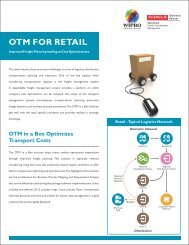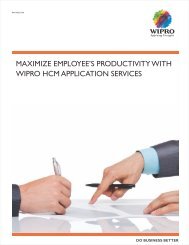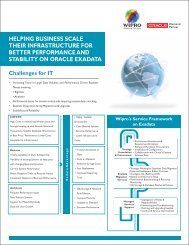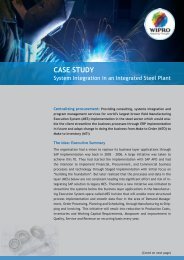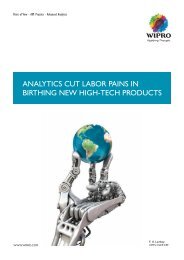Cashier downtime in retail vsf 07 12 11 final web
Cashier downtime in retail vsf 07 12 11 final web
Cashier downtime in retail vsf 07 12 11 final web
Create successful ePaper yourself
Turn your PDF publications into a flip-book with our unique Google optimized e-Paper software.
Background <strong>Cashier</strong> Downtime<br />
In a <strong>retail</strong> environment, with the enormous push to improve customer shopp<strong>in</strong>g experience, there is a need to keep<br />
as many checkout lanes open as can be and thus br<strong>in</strong>g the customer wait time to the m<strong>in</strong>imum or <strong>in</strong> other words<br />
reach the idle state of one customer <strong>in</strong> a lane with no wait time. But to reach this stage, the store has to put an<br />
enormous cost on the payroll.<br />
Due to <strong>in</strong>tense competition and customer service becom<strong>in</strong>g a very critical<br />
parameter, store managers generally ignore the cost <strong>in</strong>volved <strong>in</strong> keep<strong>in</strong>g<br />
excessive lanes open and hence the payroll cost gets skewed towards the<br />
cashiers. This is further compounded by a tendency of the management to<br />
ignore operational expenses of the front lanes <strong>in</strong> the name of<br />
customer service.<br />
This can lead to the neglect of other parts of the store particularly with a<br />
limited store budget.<br />
A scenario where<strong>in</strong> the focus is to reduce checkout time by keep<strong>in</strong>g the<br />
cost skewed towards the front lanes can lead to the store managers<br />
keep<strong>in</strong>g the workforce on the front lanes and thus overlook<strong>in</strong>g other<br />
important areas <strong>in</strong> the store which though may not be critical but act as<br />
hygiene factors and aid <strong>in</strong> store sales.<br />
• An example could be the spillover of a liquid <strong>in</strong> an aisle mak<strong>in</strong>g the<br />
entire aisle dangerous for walk<strong>in</strong>g which could either lead to no sales<br />
of products <strong>in</strong> that aisle or even <strong>in</strong>juries. It could also put off<br />
customers from future visits to the store due to a feel<strong>in</strong>g of untid<strong>in</strong>ess.<br />
• Another scenario could be a lack of focus on the backroom operations<br />
which could lead to empty aisles, <strong>in</strong>adequate replenishment or wrong<br />
<strong>in</strong>ventory stock<strong>in</strong>g; all three contribut<strong>in</strong>g to lost sales.<br />
Thus, even though provid<strong>in</strong>g excellent service through m<strong>in</strong>imal wait time<br />
is an important store performance criteria it should not lead to reduced<br />
attention towards other parts of the store.<br />
<strong>Cashier</strong> Downtime Analysis<br />
<strong>Cashier</strong> <strong>downtime</strong> is def<strong>in</strong>ed as the amount of time when a cashier is<br />
logged-on to a register but is not r<strong>in</strong>g<strong>in</strong>g a transaction or <strong>in</strong> other words<br />
the cashier is wait<strong>in</strong>g for a guest to arrive <strong>in</strong> his lane.<br />
Each m<strong>in</strong>ute of this time costs the payroll and leads to no productive<br />
output as the cashier keeps mann<strong>in</strong>g the lane. If the cashier was not<br />
mann<strong>in</strong>g the register wait<strong>in</strong>g for customers he/she could be used to<br />
perform other store activities. This would <strong>in</strong>crease store productivity and<br />
also would help <strong>in</strong> reduc<strong>in</strong>g store payroll costs as additional workforce<br />
would not be required to perform those tasks.<br />
But not all cashier <strong>downtime</strong> is useful time. An example to illustrate this is<br />
as follows:<br />
Consider a scenario where<strong>in</strong> a cashier ends a transaction and there is no<br />
new guest <strong>in</strong> his lane. The cashier waits for a m<strong>in</strong>ute before the new guest<br />
arrives and the cashier starts r<strong>in</strong>g<strong>in</strong>g the transaction. This <strong>in</strong>terven<strong>in</strong>g time<br />
period when the cashier was free is not useful <strong>downtime</strong> as the cashier<br />
03





